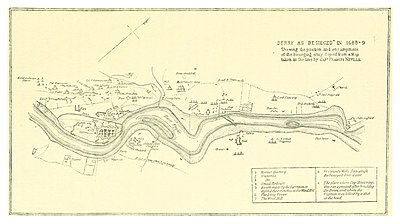Siege of Derry
The siege was preceded by an attempt against the town by Jacobite forces on 7 December 1688 that was foiled when 13 apprentices shut the gates.
The second attempt began on 18 April 1689 when James himself appeared before the walls with an Irish army led by Jacobite and French officers.
[a] On 7 May 1689, Williamite England declared war on France, quite belatedly, as French officers and experts had already been fighting William's troops at Derry before that time.
Ireland, however, was still ruled by Richard Talbot, Earl of Tyrconnell, whom James had appointed viceroy (i.e. Lord Deputy) in 1687.
Louis XIV had revoked the Edict of Nantes in 1685, which resulted in Huguenots fleeing to northern Europe and rekindled fears of persecution in Protestant communities.
He ordered Alexander MacDonnell, Earl of Antrim, a Catholic nobleman of Scottish origin, to raise the Ulster regiment.
When MacDonnell finally got his troops on the way, he met Colonel George Philips at Newtown Limavady, who immediately sent a messenger to Derry to warn the city.
[7][8] With this act Derry was in open rebellion against Tyrconnell and his master James II, who was already in exile in France at that time.
In a similar way Robert Lundy's blunders, flight, and supposed treachery (see further down) are often telescoped into the days of the apprentices' action, while in reality, they fell into the lead-up to the siege in June 1689.
In the meantime, on 12 March,[14][c] James had landed at Kinsale (on Ireland's south coast) with a French fleet of 30 men-of-war commanded by Jean Gabaret.
[16][17] French troops were needed on the continent for the Nine Years' War and were not considered necessary in Ireland as Tyrconnell had already raised a large army and only lacked equipment and the money to pay the men.
He took up quarters in the castle and established his council on which sat d'Avaux, Tyrconnell, John Drummond, Earl of Melfort, and Conrad de Rosen.
On 20 or 21 March Captain James Hamilton[20] arrived from England with the frigate HMS Jersey and the merchantman Deliverance,[21] bringing gunpowder, munition, weapons, and £595 in cash.
He also brought the commission from King William and Queen Mary that confirmed Colonel Lundy as the town's Williamite governor.
The town committee decided to build a ravelin in front of the Bishops Gate,[25] possibly using some of the money brought by Captain Hamilton.
Lundy called a council of war that decided to defend a line along the River Finn, SW of Derry, near Strabane.
On 15 April, this line was attacked by the cavalry vanguards of the two Jacobite armies, Hamilton's, which had come from Coleraine, and Rosen's, which had come from Dublin via Charlemont.
At Castlefinn they were repulsed by Colonel Skeffington's Regiment, commanded by John Mitchelburne,[31] but at Clady the cavalry under Richard Hamilton and Berwick swam through the river and routed the defenders.
Lundy kept this resolution secret, but the people in town could see that many of the gentry and officers that had been present in the council prepared to leave and went down to the river to board the ships.
The men on the wall seeing him approach interpreted this act as a breach of their agreement with Hamilton and when James and his retinue rode up to within 300 yards of Bishops Gate and summoned the city, cannons were fired at them.
He came from Culmore along the river, broke through the still quite loose ring formed by the besiegers around the town, and reached Shipquay Gate, which Captain Morrison opened for him.
[46] During another sally, on 25 April, the Duke of Berwick and Bernard Desjean, Baron de Pointis, were wounded and Pusignan killed.
[51] Matthew Plunkett, 7th Baron Louth, and de Pointis were in charge of the mortars, which were placed on the right bank of the river where no sally could reach them.
William gave that task to Major-General Percy Kirke, who decided to first explore the mouth of River Foyle to find out whether ships could get through to Derry.
[53] However, Greyhound ran aground near Fort Culmore and was damaged by cannon shot[54] before she got afloat, escaped and after some makeshift repairs limped back to Greenock in Scotland to refit.
Indeed, on 3 June, the besiegers, led by de Pointis, had placed a boom across the River Foyle about halfway between Derry and Culmore.
The fleet carried four regiments (about 3000 men: Kirke's own, Sir John Hanmer's, William Stewart's and St George's).
[57] Kirke thought that he had too few troops to challenge the besiegers in battle and the incident with the Greyhound seemed to show that it was too risky to approach the town by the river.
On 28 June Clancarty came up from Munster to Derry with his regiment and led a daring night attack against the Butcher's Gate immediately on the evening of his arrival.
On 1 August 1714, Mitchelburne hoisted a crimson flag on the steeple of St Columb's Cathedral to mark the anniversary of the relief of the city, a practice that continued for many years.





